Hyundai i800 (2008 – 2022) Review
Hyundai i800 (2008 – 2022) At A Glance
The Hyundai i800 is a big people carrier that's big on value and space. It also does something that most other people carriers can't - seat eight with a decent amount of room for luggage. On the downside, the i800 looks and feels like an old van, but on price and warranty few large MPVs come close to matching the Hyundai.
The i800 is van-based, which is obvious from its looks and is a major plus point if you're looking for loads of room inside. The strong 2.5-litre diesel engine makes light work of motorways and means that the i800 can tow up to 2300kg (braked towing weight) with a manual gearbox; however that drops to 1500kg when you fit an auto 'box.
It's out on the road that some of the commercial vehicle origins start to surface. Although the interior is well-finished and there's a decent driving position, it's awkward to park, has poor rear visibility and feels unwieldy in town. Even so, it's great for long-distance motorway trips and is a cost-effective option for larger families.
The only engine available in the i800 at launch was the 2.5-litre CRDi diesel with 170PS. From November 2008 a 135PS unit was added. Where it impresses most its low-down pulling power. With 392Nm available at 2000-2500rpm, it makes a great tow car. In fact it has a braked towing weight of 2300kg and has won awards for its towing capability. On the motorway it's an effortless cruiser and well suited to long distances; economy isn't bad either, with upwards of 33mpg possible.
Hyundai swapped the rear leaf springs in the H-1 panel van to coil suspension when it converted it into the i800. The ride is excellent as a result, smooth on the motorway and adept at soaking up lumps and ruts on bumpier roads.
The i800 doesn't handle like its immense proportions suggest. It's more than five metres long and two metres wide, but it doesn't feel like it on A and B roads, where the steering is well-weighted, the body roll is contained and there's a good amount of grip. In town it's a bit of a handful - parking can be challenging and changing lanes or filtering into traffic can take some planning. But, in its natural environment on the motorway, it's comfortable, refined and there's little in the way engine noise.
Driving the Hyundai i800 (2008 – 2022)
The only engine available in the i800 is a 2.5-litre CRDi diesel with 170PS or 135PS. Where it impresses most its low-down pulling power. With 392Nm available at 2000-25000rpm, it makes a great tow car. In fact it has a braked towing weight of 2300kg and has won awards for its towing capability, although that drops to 1500kg with the automatic gearbox.
The i800 isn't particularly quick, getting to 62mph in 14.5 seconds, but it is more than respectable for a vehicle of this size. On the motorway it's an effortless cruiser and well suited to long distances; economy isn't bad either, with upwards of 33mpg possible.
Hyundai smartly swapped the rear leaf springs in the H-1 panel van to coil suspension when it converted it into the i800. The ride is excellent as a result, smooth on the motorway and adept at soaking up lumps and ruts on bumpier roads.
The i800 doesn't handle like its immense proportions suggest. It's more than five metres long and two metres wide, but it doesn't feel like it on A and B roads, where the steering is well-weighted, the body roll is contained and there's a good amount of grip. In town it's a bit of a handful - parking can be challenging and changing lanes or filtering into traffic can take some planning. But, in its natural environment on the motorway, it's comfortable, refined and there's little in the way engine noise.
Hyundai i800 (2008 – 2022) interior
The interior of the i800 isn't as utilitarian as you might expect. The build quality goood but the shiny scratchy plastics give the i800 the feel of an old van. That said, the chunky buttons are easy to use on the move and it's constructed from quality materials. Plus there are a few little luxuries like a leather steering wheel and a heated driver's seat.
It's easy to get in-and-out of too, thanks to large doors and plenty of seat movement in the back. There's room for six in the back, with three in each of the two back rows. The seats are comfortable and there's a decent amount of head and legroom - it never feels cramped. The second row of seats slide forward to increase leg and knee room for those behind and both rear rows get independent ventilation and lighting controls too.
The amount of load space on offer is staggering. Even with eight people on board, there's 851-litres of boot space on offer without fold a single seat - that's enough for several suitcases. The seats themselves can't be removed, but they do fold flat, split and fold 60:40 and the centre seats also side. It means that the i800 can carry almost any load.
The driver sits high, which gives a good view of the road ahead, although the view out of the back is rather limited. The driving position is good, but not without fault. The seat doesn't offer enough support for longer journeys, the steering wheel adjusts for height only and there aren't any steering wheel controls for the stereo, which means quite a stretch to change radio station. On the plus side, the steering wheel-mounted gearstick is only convenient, but also frees up a huge amount of space between the driver and passenger seats.
Model History
March 2008
i800 launched in the UK
Based on the H-1 'Grand Starex' van, the i800 seats eight, but has a different rear axle (coils rather than leaves etc) and a posher interior. Eight seats (2-3-3 formation). Its 2.5 turbodiesel producing 170PS and 392Nm of torque. Price £19,495 Style Spec - Alloys, ESP, air con, trip computer, privacy glass, parking sensors, heated seats, dimming rear view mirrors etc. Combined economy 33.2mpg. Thanks to a 75 litre tank, it means the i800 driver could go more than 560 miles between fill ups. Under 225g/km CO2.
5,125mm long x 1,920mm wide x 1,925mm high on 3,200mm wheelbase.
Lower spec, lower power 'Comfort' version with 130bhp from November 2008. Loses the privacy glass, parking sensors, dimming mirror, the two tone paint and 40PS. Price will be about £18,500.All 5-speed manual, rear wheel drive. Is an auto, but jumps into VED band G so special order only.
851 litres of space in the boot even when loaded with passengers. That’s twice as much as some estate cars, and even twice as much as the VW Caddy Maxi Life.The Hyundai i800 features a pair seats in front and two benches behind, each accommodating three adults in comfort with uncompromised head and legroom.
Both rear benches feature a 60:40 split-fold and recline while the centre row also slides forwards or backwards to tailor space as required. All of the rear seats are accessed by pair of sliding doors, making access easy wherever the i800 is parked.
Once inside, the ambience is far more car-like than other ‘minibus’ style rivals, with two-tone interior trim, privacy glass, a six-speaker audio system and ducted air conditioning throughout. Individually-controllable overhead vents in the rear make sure all of the occupants can keep their cool.16-inch Alloy wheels are also standard. Full sized spare wheel. ESP and traction control systems plus dual airbags. In addition, all occupants have three-point seatbelts.Turning circle just 5.61m. In addition, electronic reversing sensors are standard.As with all Hyundai cars, the i800 is covered by a five year, manufacturer backed, unlimited mileage warranty.
May 2013
Manual now has six-speed transmission, automatic is five-speed. Prices have risen to £22,700 for the 136PS 6-speed manual and £24,620 for the 170PS 5-speed automatic. Manual towing limit is 2,300kg; but automatic towing limit is only 1,500kg.
Variable geometry turbocharger of previous engine replaced by waste gate set-up, resulting in less power and torque. The new 2.5 engine/manual gearbox makes official figures of 100kW and 343Nm, down from 125kW/392Nm, although the later model hits its peak torque earlier, arriving from a low 1,500rpm.
Five-speed automatic versions got a hike in torque output, with the engine retaining the variable geometry turbocharger and now making 125kW and 441Nm (up from 125kW/392Nm). But maximum torque is in a narrow band from 2,000 to 2,250rpm instead of 2,000 to 2,500rpm.

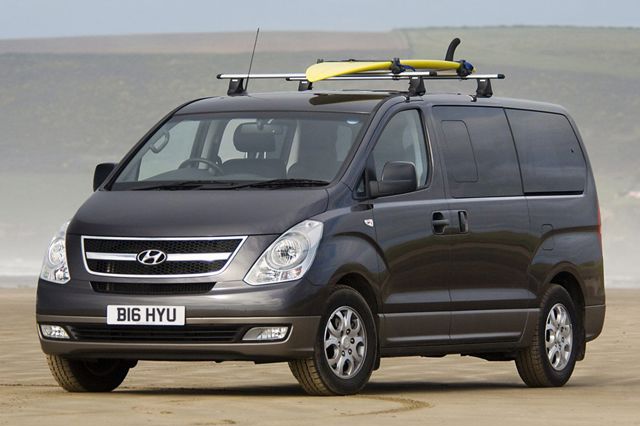
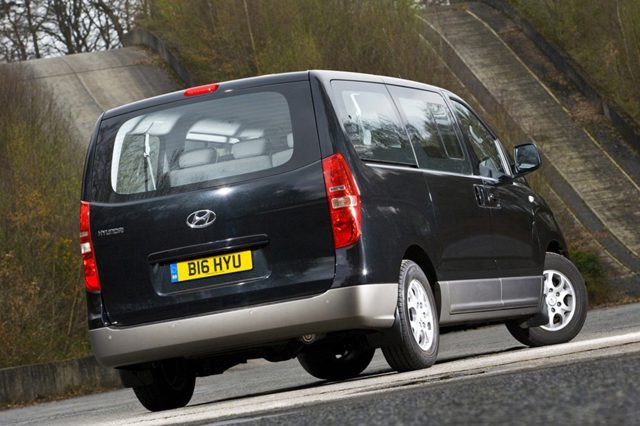
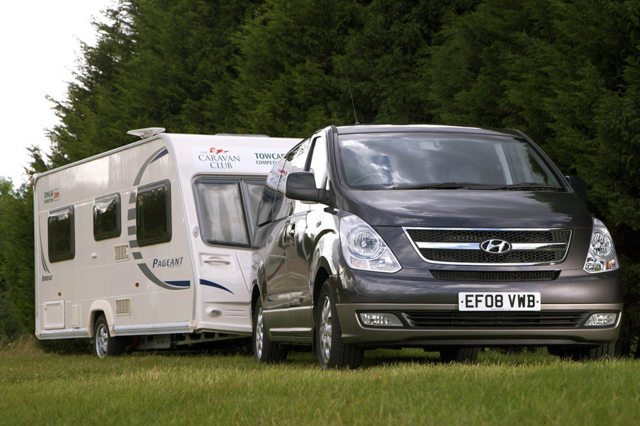
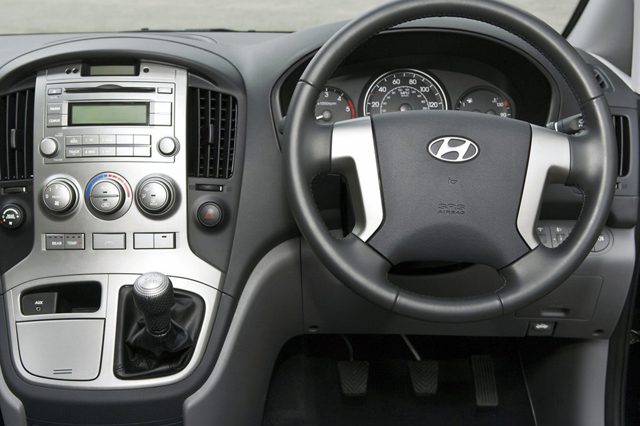
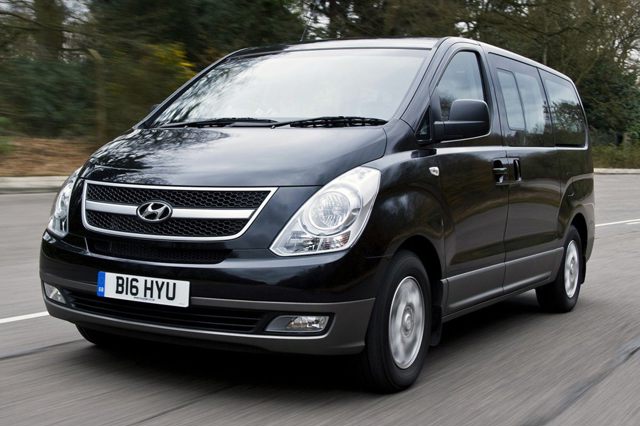

 Strong and quiet initially 2.5-litre diesel engines, eight seats with plenty of space for all, good value, sold with a five-year-warranty as standard.
Strong and quiet initially 2.5-litre diesel engines, eight seats with plenty of space for all, good value, sold with a five-year-warranty as standard.
 Big and bulky size means it's not very easy to park, interior quality and design is starting to look and feel its age.
Big and bulky size means it's not very easy to park, interior quality and design is starting to look and feel its age.